The Exploring the Realm Scans A Comprehensive Guide

Realm Scans In today’s digital age, the term ‘scan’ has transcended its traditional boundaries to encompass many processes and technologies. From document digitization to 3D scanning and medical imaging to security applications, the Realm Scans plays a pivotal role in various industries. This comprehensive guide delves into the multifaceted world of scans, offering insights into its applications, benefits, challenges, and future trends.
Realm Scans and Their Importance
At its core, scanning involves capturing physical or digital entities and converting them into a digital format. This process is crucial for preserving, analyzing, and sharing information. Scanning helps digitize paper documents in document management, making them easily accessible and searchable. Meanwhile, in the medical field, MRI and CT scans are indispensable for diagnosing and treating diseases.
The Evolution of Scanning Technology
The evolution of scanning technology has been remarkable, moving from simple document scanners to advanced 3D scanning and beyond. Early scanners were limited in resolution and speed, but today’s scanners boast high precision, efficiency, and the ability to capture in multiple dimensions. This evolution is reflected in applications such as quality control in manufacturing, where 3D scans ensure products meet specifications with utmost accuracy.
Types of Realm Scans and Their Applications
- Scanning technology can be categorized into several types, each serving distinct purposes:
- Document Scanning: Converts paper documents into digital formats, facilitating more accessible storage, retrieval, and management.
- 3D Scanning: Captures the physical form of objects in three dimensions, crucial for manufacturing, virtual reality, and historical preservation.
- Medical Scanning: Includes technologies like MRI, CT scans, and ultrasound, essential for medical diagnostics and research.
- Security Scanning: Encompasses biometric and X-ray scanning methods, pivotal for identity verification and safety protocols.
- Each scanning: type finds relevance in specific industries, underscoring the versatility and indispensability of scanning technologies.
Benefits of Scans in Various Sectors
- The integration of scanning technology brings myriad benefits across sectors:
- Efficiency and Productivity: Realm Scans convert physical entities into digital formats quickly and accurately, streamlining workflows and saving time.
- Space Saving: Digital documents reduce the need for physical storage, freeing up space and reducing clutter.
- Enhanced Accessibility: Digital formats can be easily shared and accessed anywhere, improving collaboration and decision-making.
- Improved Security: Digital documents and data can be encrypted, password-protected, and backed up, enhancing security and disaster recovery.
Challenges and Considerations
Despite the benefits, the Realm Scans faces challenges. Privacy and security of scanned information are paramount, especially with sensitive data. Ensuring data protection requires robust cybersecurity measures. Additionally, scanning technologies’ initial cost and complexity can be barriers for small businesses. However, advancements in technology and increasing affordability are gradually overcoming these challenges.
Future Trends in Scanning Technology
The future of scanning technology is promising, with innovations aimed at increasing speed, accuracy, and applications. Artificial intelligence (AI) and machine learning (ML) are set to revolutionize scanning processes, enabling more innovative, efficient, and automated solutions. Furthermore, integrating scanning technology with blockchain could enhance security and transparency in document management.
The Role of Scans in Sustainability
Scanning technology also plays a crucial role in sustainability efforts as digital transformation accelerates. Realm Scans reduce environmental impact by reducing reliance on paper and facilitating digital workflows. Future developments in scanning technology will likely emphasize eco-friendly practices and sustainability.What is scanning technology?
Scanning technology involves capturing a physical object or document and converting it into a digital format. This can include converting paper documents into PDFs or creating digital 3D models of physical objects.What are the main types of scans?How does 3D scanning work?
Conclusion
The Realm Scans is vast and dynamic, touching almost every aspect of modern life. From improving business operations to advancing medical diagnostics and enhancing security measures, scanning technology has become an indispensable tool. As we look to the future, continued innovation in scanning technology promises to refine its current applications and unlock new possibilities. Embracing these advances will be critical to leveraging the full potential of Realm Scans, driving efficiency, and fostering sustainability in an increasingly digital world.

Post Comment